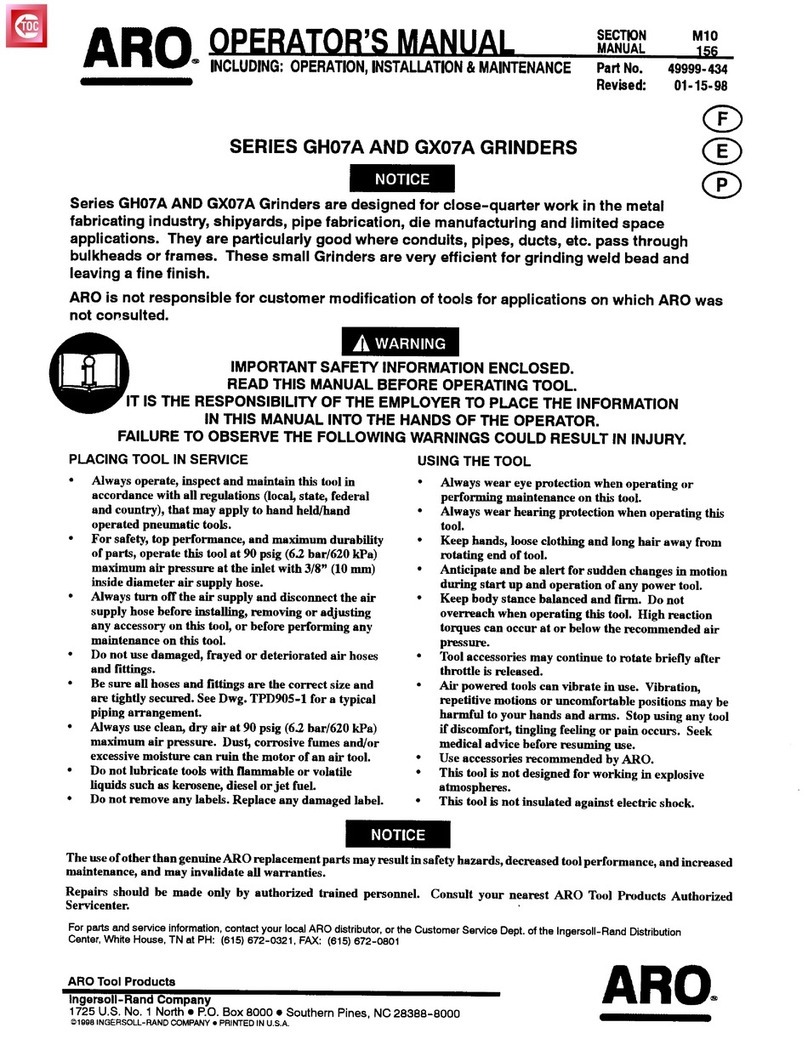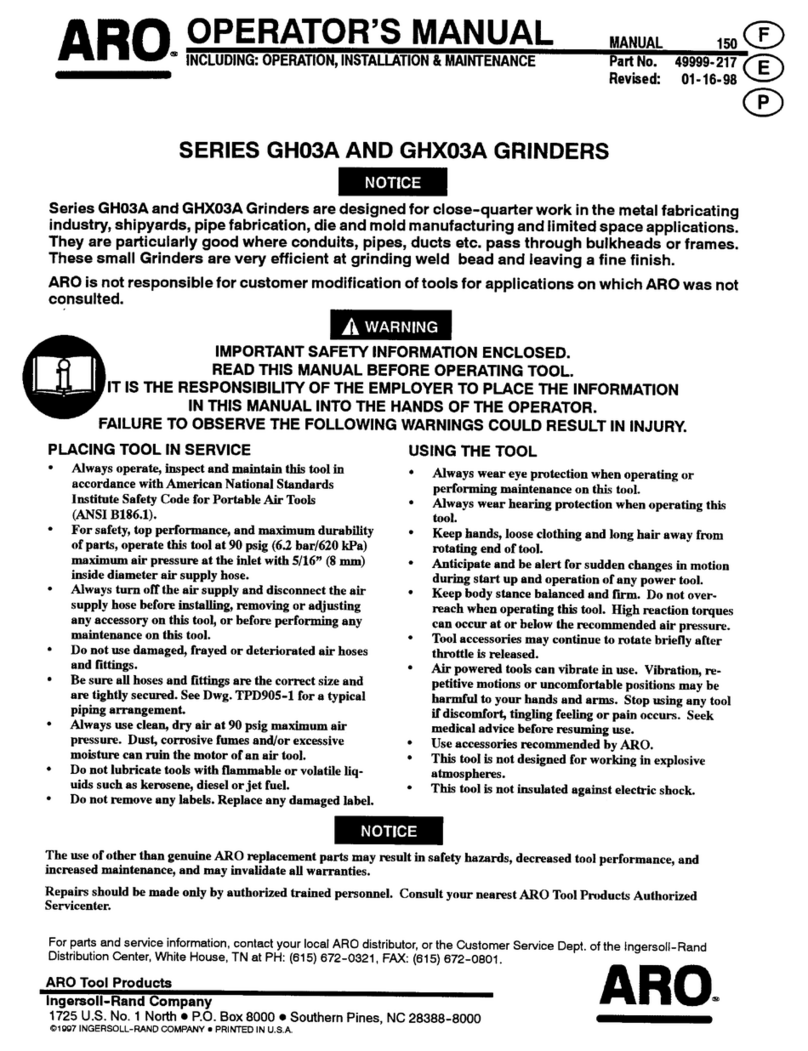GRINDING WHEEL MOUNTING INSTRUCTIONS
M10
43
Disconnectair supply fromgrinderorshutoffairsupply and exhaust (drain)air
lineofcompressedair beforemountingorremovingany abrasivewheelorwire
brush,or otherwise performingmaintenanceor service to the tool.
Check abrasive wheels prior tomounting forchips orcracks.Cracked orchipped
wheels shall not be used.
Caremustbetakenthatagrindingwheel,orwirebrush,ofthecorrectspeedrat-
ingisused.RatedwheelcapacitiesforArogrindersaremaximumonly.Regard-
lessoftheratedcapacityandspeed ofanyArogrinder,abrasivewheelsorwire
brushesshallneverbe operatedat a speed greaterthan that recommendedby
the wheel (orbrush)manufacturer.
Checkgrinderspeed beforemountinggrindingwheel (orothertype accessory)
withareliabletachometertomakesurethattheactualspeedofthegrinderdoes
notexceed its ratedfree speed.
Checkoperatingspeedofgrindingwheelorwirebrushtobeusedwiththegrind-
er.The maximumoperating speed marked on the grinding wheel, blotters or
packaging,shallequal or exceed the ratedfree speed ofthe grinder.Also,the
type andsize of the grindingwheel or wire brush shall be compatible with the
grindersize and type.
DressingAbrasive Wheels.Uponmountinga grindingwheel,thetoolshouldbe
operated at gradually increasing speed and checked for good balance of the
wheel. Ifunbalanceisobserved,thewheel shall be dressed.Ifdressingfailsto
establish acceptable balance, the wheel shall not be used.
MOUNTING INSTRUCTIONS FOR MOUNTED WHEELS
FOR USE WITH COLLET ASSEMBLIES.
Thecolletshallbe checkedto assureitto be ingoodconditionandproperlyaf-
fixed to the grinder spindle.
Themandrelshallbeinsertedtothefulldepthofthegrippingjawsofthecollet.At
least 1/2the mandrel length shall be insertedintothe Collet.
Themaximumsafeoperatingspeedformountedwheelsshallbedeterminedby
thefollowing:1.)Shapeandsize ofthe mountedwheel, 2.)Sizeofmandreland
3.)Overhang ofmandrel.Innocase shall the maximum safe operating speed rec-
ommendedby the wheel manufacturerbe exceeded.
WARNING:Workpressure,if excessive,canbethecauseoftroubleanda
sourceof danger,thru bendingor fractureof the mandrel.Pressurebe-
tweenthewheelandtheworkshouldneverbesoheavythatspringingof
the mandrelwill result.
MANDREL OVERHANG - DIMENSION “0”
FIGURE1
IMPORTANTNOTICE:lncreaslng the overhangofthemandrelwill reducethemaximumwheelsizethatcanbesafelyusedwiththespeedofthetool(dlmen-
slon“0”,figure1).Also,thelengthanddiameterofmandrelcombinedwiththesizeandshapeofthewheelaredeterminingfactorswhichmustbeconsid-
eredwhenselectingamountedwheelthatwill becompatiblewith theratedfreespeedofthetool.Itis recommendedthe“TablesofMaximumOperating
Speedsfor MountedWheels”oftheAmericanNationalStandardpublication87.1-1979previouslymentionedorotherreliablesource,beconsultedto
determinethe safeoperatingspeedof a particularsizeandshapeof wheelcombinedwith the sizeandoverhangof mandrel.
MOUNTING INSTRUCTIONS FOR TYPE 1 GRINDING WHEELS
Thedrivingflangeshallbe inspectedtoseethat itisofthe relievedtype, thatits
diameterisatleast 1/3thediameterofthewheelandthatitisfreeofnicks,burrs
andsharpedges.A blotter,separateorattachedtothewheelandat leastthedi-
ameter ofthe driving flange, shallbear againstthe driving flange. The wheel shall
be placed onthe spindle followingthefirstblotter. Thewheel shall notfittoo snug-
ly nortoo freely on the spindle. The normal diametral clearance between the
wheel
and
the spindle is approximately ,007” (.17 mm) maximum. Abrasive
wheelswhichdonotproperlyfitthespindleshallnotbeused.Separatereducing
bushings,unlesssuppliedorrecommendedbytheabrasivewheelmanufacturer,
shall notbe usedto adapt larger hole abrasive wheels.
A secondblotter,separateorattachedtothewheel andat leastthe diameterof
the outside flange, shall followthe wheel on the spindle. An outer flange, the
same diameter as the drivingflange,shall followthe secondblotter.The outer
flange
shallhavea reliefandcontactfaceidenticaltothe drivingflange,placedtoward
the blotter.
A spindle end nut shall followthe outer flange. Holdspindle fromrotatingand
screwspindle end nutsfirmlyagainst the outerflange, butonly tightenoughto
insuresufficientfrictionontheblotterfacestodrivethewheel.Excessivetighten-
ingcandistorttheflanges.The spindleshallprojectflushwithorpasttheendof
thespindleendnut.Tosecurewheelsthinnerthan the unthreadedlengthofthe
spindle,a spacer shallbe usedbetweenthe flange andthe spindle end nut. Such
aspacershallbeaprecisionpart,withparallelfacesrunningtruetothespacer’s
center hole.
The safetyguardshall be properlypositionedandthe mountingcheckedtoas-
sure secure positioning.The guard cover shall be closed and secured.
MOUNTINGINSTRUCTIONSFORTYPES16,17,18,18RAND19CONEANDPLUGWHEELS
FOR USE WITH 37292-( ) WHEEL ADAPTER
Thedrivingflangeshall be inspectedto seethat it isoftheflat,unrelievedtype,
thatitsdiameter isatleast1/3the diameterofthewheel and that
itisfreeofnicks, diameter of the driving flange, shall bear against the driving flange.
burrsandsharpedges.
Thegrindingwheelshallbetightenedonthespindlebyhand and shallbearfirmly
The spindle and wheel threads shall be inspected tosee that they are ofthe same
againsttheblotteranddrivingflange.Ifthewheelcannotbesecured,thespindle
pitchand diameterandablotter,separate orattachedtothewheelandatleastthe length shallbe checked.Ifthe spindle length iscorrect and the cone wheel stillwill
notfitfirmlyagainsttheblotteranddrivingflange,thewheelshallnotbeusedand
a proper fittingwheel shall be selected.
5































